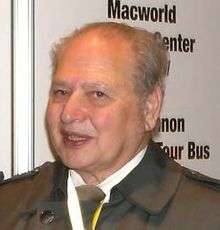Ronald Wayne
| Ronald Wayne | |
|---|---|
 Ronald Wayne at Macworld 2009 | |
| Born |
Ronald Gerald Wayne May 17, 1934 Cleveland, Ohio, U.S. |
| Known for | Cofounding Apple Inc. |
Ronald Gerald Wayne (born May 17, 1934) is a retired American electronics industry worker. He co-founded Apple Computer (now Apple Inc.) with Steve Wozniak and Steve Jobs, providing administrative oversight for the new venture. He soon, however, sold his share of the new company for $800 US dollars, and later accepted $1,500 to forfeit any claims against Apple (in total, equivalent to $9,200 in 2015). As of April 2016, if Wayne had kept his 10% stake in Apple Inc.[1] it would have been worth almost $60 billion.[2]
Early life
Wayne was born in Cleveland, Ohio, United States on May 17, 1934.[3] He trained as a technical draftsman at the School of Industrial Arts in New York. In 1956 he moved to California. Wayne's first business venture was a company selling slot machines. The company failed, with Wayne reflecting in 2014 that, "I discovered very quickly that I had no business being in business. I was far better working in engineering."[4]
Career
Apple

Wayne worked with Steve Jobs at Atari before he, Jobs, and Wozniak founded Apple Computer on April 1, 1976. Serving as the venture's "adult supervision",[5] Wayne drew the first Apple logo, wrote the three men's original partnership agreement,[6] and wrote the Apple I manual.[5][7]
Wayne received a 10% stake in Apple but relinquished his equity for US$800 less than two weeks later, on April 12, 1976.[7][8] Legally, all members of a partnership are personally responsible for any debts incurred by any partner; unlike Jobs and Wozniak, then 21 and 25, Wayne had personal assets that potential creditors could seize.[7][9] The failure of a slot machine company that he had started five years earlier also contributed to his decision to exit the partnership.[5]
Later that year, venture capitalist Arthur Rock and Mike Markkula helped develop a business plan and converted the partnership to a corporation. A year after leaving Apple, Wayne received $1,500 for his agreement to forfeit any claims against the new company.[5] In its first year of operations (1976), Apple's sales reached US$174,000. In 1977 sales rose to US$2.7 million, in 1978 to US$7.8 million, and in 1980 to US$117 million. By 1982 Apple had a billion dollars in annual sales. In February 2015, Apple's value exceeded $700 billion, making it the most valuable U.S. company by far. Had Wayne kept his 10% stock until then, it would have been worth billions.[10]
Wayne has stated that he does not regret selling his share of the company as he made the "best decision with the information available to me at the time".[11] Wayne also stated that he felt the Apple enterprise "would be successful, but at the same time there would be significant bumps along the way and I couldn't risk it. I had already had a rather unfortunate business experience before. I was getting too old and those two were whirlwinds. It was like having a tiger by the tail and I couldn't keep up with these guys."[6]
Post-Apple
After leaving Apple, Wayne resisted Jobs' attempts to get him to return, remaining at Atari until 1978, when he joined Lawrence Livermore National Laboratory and later an electronics company in Salinas, California.[11]
Wayne retired to a Pahrump, Nevada mobile home park[12] selling stamps and rare coins in Pahrump. Wayne never owned an Apple product[5][13] until 2011, when he was given an iPad 2 by Aral Balkan at the Update Conference in Brighton, England.[14]
Wayne also ran a stamp shop in Milpitas, California for a short time in the late 1970s, Wayne's Philatelics. After a number of break-ins, he moved his stamp operations to Nevada. The logo for the business was a wood-cut style design, with a man sitting under an apple tree, with the "Wayne's Philatelics" name written in a flowing ribbon curved around the tree. This was the original logo he designed for Apple Computer.
In the early 1990s Wayne sold the original Apple company agreement, signed in 1976 by Jobs, Wozniak and himself, for $500. In 2011 the contract was sold at auction for $1.6 million. Wayne has stated that it is the one thing he regrets about his involvement with Apple.[15][4][16]
He holds a dozen patents.[17]
Author
Wayne published a memoir titled, Adventures of an Apple Founder, in July 2011. Plans for initial exclusivity on the Apple iBookstore did not pan out.[18]
Wayne has also written a socio-economic treatise titled Insolence of Office, released on October 1, 2011 which he describes as:[18]
...the product of decades of research and observation into the evolution of human governance, and the foundations of the American Constitutional Republic. Through this analysis the reader is introduced to a complete, yet simplified understanding of the architecture of our Constitution, its foundations, principles, and the essential meaning of its structure all in the context of modern living.
Documentaries
Wayne appeared in the documentary Welcome to Macintosh where he describes some of his experiences with Steve Jobs, Steve Wozniak, and Apple Computer.[19]
Personal life
Wayne came out as gay to Jobs shortly after February 1974, while both men were employees at Atari. Jobs later recalled, "It was my first encounter with someone who I knew was gay." Wayne recalled in 2011 that, "Nobody at Atari knew, and I could count on my toes and fingers the number of people I told in my whole life. But I guess it just felt right to tell him, that he would understand, and it didn't have any effect on our relationship."[20]
References
- ↑ Dan Simon, The gambling man who co-founded Apple and left for $800 CNN, June 24, 2010
- ↑ Dave Lee, Apple at 40: The forgotten founder who gave it all away BBC News 1 April 2016
- ↑ "Bio". Ronald G Wayne official site. Archived from the original on February 23, 2015. Retrieved September 2, 2015.
- 1 2 Dormehl, Luke (December 3, 2014). "The oddly uplifting story of the Apple co-founder who sold his stake for $800". Cult of Mac.
- 1 2 3 4 5 "Woz, Jobs and ... Wayne? Apple's forgotten founder still wandering in the desert". Mercury News. San Jose, California. June 2, 2010. Archived from the original on June 3, 2010.
Twelve days after Wayne wrote the document that formally created Apple, he returned to the registrar's office and renounced his role in the company. When Jobs and Wozniak filed for incorporation a year later, Wayne received a letter asking him to officially forfeit any claims against the company, and he received another check, this time for $1,500.
- 1 2 "US pensioner Ronald Wayne gave up £15bn slice of Apple". The Daily Telegraph. UK. April 23, 2010. Archived from the original on November 14, 2012. Retrieved September 2, 2015.
- 1 2 3 Wozniak, Steve. "Letters-General Questions Answered". Steve Wozniak official site. Archived from the original on August 17, 2000. Scroll down to third letter.
- ↑ Simon, Dan (June 24, 2010). "The gambling man who co-founded Apple and left for $800". CNN. Archived from the original on June 26, 2010. Retrieved June 24, 2010.
Wayne left Apple for only $800. "What can I say? You make a decision based on your understanding of the circumstances, and you live with it," he said.
- ↑ Seibold, Chris (April 12, 2009). "April 12, 1976: Ron Wayne, Apple's Third Founder, Quits". Apple Matters. Archived from the original on February 1, 2015.
- ↑ Gillespie, Patrick (February 13, 2015). "Apple: First U.S. company worth $700 billion". CNN. Archived from the original on August 11, 2015. Retrieved February 13, 2015.
- 1 2 Linzmayer, Owen W. "Chapter one: The Forgotten Founder". Apple Confidential: The Real Story of Apple Computer, Inc. No Starch Press via The Denver Post. Archived from the original on April 11, 2015. Retrieved March 31, 2010.
- ↑ "Pahrump Nevada Man Could Have Been Apple Billionaire now lives in Mobile Home Park". RealPaurump.com. June 25, 2010. Archived from the original on August 28, 2014. Retrieved July 5, 2010.
- ↑ Newman, Bruce (June 9, 2010). "For obscure Apple co-founder, misstep was a costly one". The Seattle Times. Archived from the original on August 31, 2011.
- ↑ Brian, Matt (September 11, 2011). "Apple's co-founder Ron Wayne on its genesis, his exit and the company's future". The Next Web. Retrieved September 13, 2011.
- ↑ Luo, Benny (September 12, 2013). "Ronald Wayne: On Co-founding Apple and Working With Steve Jobs". Nextshark.
- ↑ Blackden, Richard (December 13, 2011). "Apple's founding document sold for $1.59m at auction". The Daily Telegraph. Archived from the original on February 24, 2016.
- ↑ John C Abell (June 3, 2010). "Apple Co-Founder Ron Wayne's Long, Strange – and Sad – Trip". Wired. Archived from the original on October 27, 2014. Retrieved November 11, 2010.
- 1 2 "Adventures of an Apple Founder on iTunes store". Ronald G Wayne. September 3, 2011. Archived from the original on October 1, 2011. Retrieved November 11, 2010.
- ↑ 512k Entertainment (January 1, 2008). "Life Before Apple". Archived from the original on September 2, 2015.
- ↑ Isaacson, Walter (2011). Steve Jobs. Simon & Schuster. p. 44. ISBN 978-1451648539.
External links
- Official website
- Ron Wayne interview by OMT
- NPR report "Lost" Apple Founder Has No Regrets – June 13, 2010
- Ron Wayne, Apple Co-Founder, Shares Steve Jobs' "Richest Man in the Cemetery" Sentiment Almost Verbatim, Village Voice, October 8, 2011
- Ronald G. Wayne interviewed on the TV show Triangulation on the TWiT.tv network
